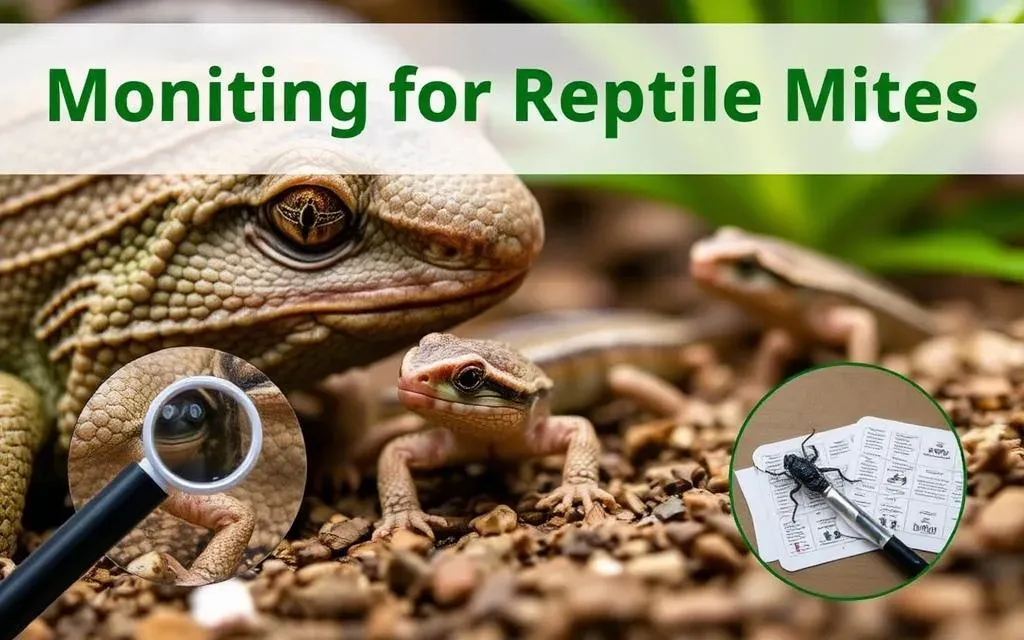Reptile mites can be a big problem for pet owners. But, with the right steps, you can get rid of these pests and keep your reptiles healthy. This guide will show you how to deal with reptile mites and stop them from coming back.
As reptile lovers, we know how important it is to keep our pets free from mites. Whether you’re fighting an infestation or want to protect your reptiles, this article will give you the knowledge and tools you need. You’ll learn how to take charge of the situation.
We’ll talk about what reptile mites are, how to spot an infestation, and the best ways to get rid of them. You’ll find out about chemical treatments and natural remedies. We aim to give you the information you need to keep your reptiles safe and healthy.
Table of Contents
ToggleUnderstanding Reptile Mites
Reptile mites are tiny, parasitic arachnids that live off reptiles’ blood. They can be a big threat to our scaly pets’ health. Knowing about reptile mites and how to spot an infestation is key to dealing with them.
What Are Reptile Mites?
Reptile mites look like small spiders and are part of the Acarina order. They’re under 1 millimeter big and hard to see with just your eyes. These mites drink reptiles’ blood, like snakes, lizards, and turtles. If not treated, they can cause health problems.
Signs of a Reptile Mite Infestation
Knowing the signs of reptile mites lets you act fast. Look out for:
- Visible mites on the reptile’s skin or in its home
- Excessive scratching, rubbing, or irritation from the reptile
- Scaly or crusty skin patches from mite bites
- Loss of appetite or being very tired
- Tiny black dots (mite droppings) on the reptile or in its home
If you think your reptile has mites, act fast. This stops the problem from getting worse and hurting your pet more.
Preparing for Mite Elimination
Before we tackle reptile mites, we must prepare your reptile’s home for success. Let’s walk you through the key steps to make a mite-free space.
Start by checking your reptile’s home for mites. Look in all hiding spots and under every surface. This helps you see how bad the problem is and where to focus your cleaning.
- Disassemble the enclosure: Take apart any parts you can, like decorations and hides, for a deep clean.
- Clean and disinfect: Use a safe reptile disinfectant on everything in the enclosure. This kills mites and their eggs.
- Dispose of contaminated materials: Throw away any bedding or items that are full of mites to stop them from spreading.
Now, get your reptile ready for the cleaning. Move it to a safe place without mites while you clean and treat the enclosure.
Getting ready is crucial to beat reptile mites and keep them away. By doing these steps, you’re on the right path to a mite-free home for your reptile.
How to Get Rid of Reptile Mites
Chemical Treatments
Chemical treatments are a strong way to get rid of reptile mites. Many people use sprays or dips made just for reptile mites. These products have things like permethrin or pyrethrin that kill the mites and their eggs.
Always read the product label carefully and pick a chemical that’s safe for your reptile. Using chemicals wrong can hurt your pet. So, do your homework and talk to a vet before using them.
Natural Remedies
If you don’t want to use chemicals, natural ways to fight reptile mites work too. Essential oils like tea tree oil or lavender oil can keep mites away.
Using diatomaceous earth in your reptile’s home is another natural method. This powder can dry out and kill mites by breaking their outer shells. Make sure it’s safe for food and apply it carefully to avoid bothering your pet’s lungs.
Choosing chemical or natural treatments, make sure to clean and disinfect your reptile’s home well. This helps get rid of any mites left and stops more from coming back. With the right ways to get rid of mites and clean their home, you can keep your reptile happy and free of mites.
| Chemical Treatments | Natural Remedies |
|---|---|
| Insecticidal sprays or dips containing permethrin or pyrethrin | Essential oils like tea tree oil or lavender oil |
| Follow label instructions and consult a veterinarian | Diatomaceous earth (food-grade) |
| Effective in killing mites and their eggs | Dehydrate and eliminate mites by damaging their exoskeletons |
Preventing Future Infestations
After getting rid of reptile mites from your pet’s home, it’s key to stop them from coming back. You must follow proper quarantine steps and keep your reptile’s home clean and healthy. This will help keep your pet free from mites.
Quarantine Procedures
Quarantining new reptiles is vital to stop mites or pests from spreading to your other reptiles. Here are the steps to follow when adding a new reptile:
- Put the new reptile in a separate area for 30-60 days.
- Check the new reptile for any signs of mites or parasites.
- Give the new reptile a vet-approved treatment for mites before it meets your other pets.
- Clean all items used for the new reptile before using them with your other pets.
Habitat Maintenance
Keeping your reptile’s home clean is key to avoiding mite problems. Here are some tips to help:
- Clean and disinfect the enclosure every week, taking out all the substrate and decorations.
- Make sure the water is fresh and change it often.
- Keep the temperature, humidity, and air flow right in the habitat to make it hard for mites to live.
- Use a vacuum and disinfect around the reptile’s home to get rid of any mites or eggs.
By doing these things, you can stop reptile mites from coming back and keep your pet happy and healthy.
Treating Your Reptile
Dealing with reptile mites requires the right treatment and support for your pet. Mites can harm your reptile’s health and well-being. We’ll cover the key steps to help your reptile recover and stay healthy.
First, treat the mite infestation quickly. Waiting too long can make things worse for your reptile. Work with your vet to create a treatment plan for your pet and its home.
Provide Supportive Care
Your reptile may need extra care during treatment. This includes:
- Creating a clean, stress-free space for healing
- Ensuring your pet gets enough water and food to fight off infection
- Watching for signs of other infections and treating them fast
Observe for Signs of Improvement
Watch your reptile closely as it gets treatment. Look for signs it’s getting better, like:
- Less itching and scratching
- Better skin and fewer scales or lesions
- More appetite and energy
Regular vet visits will help make sure the treatment works and your reptile is recovering.
Supporting your reptile’s health during a mite infestation is key for its well-being. By working with your vet and giving the right care, you can help your reptile beat this issue and shine again.
Cleaning and Disinfecting
Keeping your reptile’s home clean and disinfected is key to getting rid of reptile mites and stopping them from coming back. We’ll show you how to clean your reptile’s enclosure right and use effective disinfecting methods to keep it mite-free.
Enclosure Cleaning
Start by cleaning your reptile’s home thoroughly. Take out all items like decorations, substrate, and hiding spots. Clean them with a safe cleaner for reptiles. Make sure to check crevices and corners for mites.
- Vacuum or wipe down the enclosure’s walls and surfaces to remove any visible mites or debris.
- Replace the substrate with fresh, clean material.
- Throw away and replace any hiding spots or decorations that can’t be cleaned well.
Disinfecting Techniques
After cleaning, disinfecting the enclosure and its contents is crucial to kill any mites or eggs left behind. Use a safe disinfectant for reptiles, like diluted bleach or a reptile habitat disinfectant.
- Spray or wipe down all surfaces, including walls, floor, and items, with the disinfectant solution.
- Let the disinfectant work for the recommended time, usually 10-15 minutes, before cleaning off.
- Make sure everything is dry before putting the enclosure back together and bringing your reptile home.
By using these effective cleaning methods for reptile mites and disinfecting techniques, you can make a clean and disinfected reptile habitat. This will keep your reptile safe from mites and ready for its home.
Seeking Professional Help
Many reptile mite problems can be fixed at home. But sometimes, you need a pro. If your pet has a bad mite problem or is getting sick, see a reptile vet or specialist. They know how to get rid of the mites and keep them away.
Here are some times to call a reptile vet for mites:
- If the mite infestation is widespread and your reptile’s health is deteriorating
- If the mites are not responding to your DIY treatment efforts
- If you suspect the mites are causing your reptile significant distress or discomfort
- If you’re unsure about the appropriate treatment methods or how to properly implement them
A reptile vet can give your pet the right treatment, like prescription meds and special cleaning. They can also figure out why you got mites and help you stop them from coming back.
For serious mite problems, find a vet or specialist who knows about reptile parasites. They will check your pet, suggest the best treatments, and teach you how to keep your pet healthy and mite-free.
| When to Call a Reptile Vet for Mites | Benefits of Professional Reptile Mite Treatment |
|---|---|
|
|
Monitoring and Follow-up
Getting rid of reptile mites is just the first step. You must keep a close watch to stop them from coming back. This way, you can spot any new problems early and deal with them fast.
Ongoing Vigilance
After treating your reptile and its home for mites, keep a sharp eye on things. Look for signs of recurring reptile mite infestations, like:
- Visible mites or their eggs on your reptile’s skin or in the enclosure
- Excessive scratching or rubbing behavior from your reptile
- Patches of irritated, red, or flaky skin on your reptile
Check your reptile’s home often, especially in places where mites might hide, like in the substrate or decorations. Keep your reptile’s home mite-free by cleaning and disinfecting it regularly.
| Monitoring Tip | Frequency |
|---|---|
| Visual inspection of your reptile | Daily |
| Thorough cleaning of the enclosure | Weekly |
| Monitoring for reptile mites after treatment | Daily for the first week, then weekly |
By staying vigilant, you can catch any new mite problems early. This keeps your reptile healthy and happy.

Conclusion
We’ve looked at a lot of ways to get rid of reptile mites and keep your pets healthy. Getting rid of reptile mites means understanding the problem and using the right strategies to stop them.
First, we need to know about reptile mites and how to spot an infestation. Then, we can use different methods to get rid of them. These include both chemical and natural treatments. It’s also key to prevent mites by keeping your reptile’s home clean and safe.
In conclusion, the main points for controlling reptile mites are to be alert, act fast, and keep their living area clean. By doing these things, you can get rid of reptile mites and keep your reptiles happy and healthy.
















